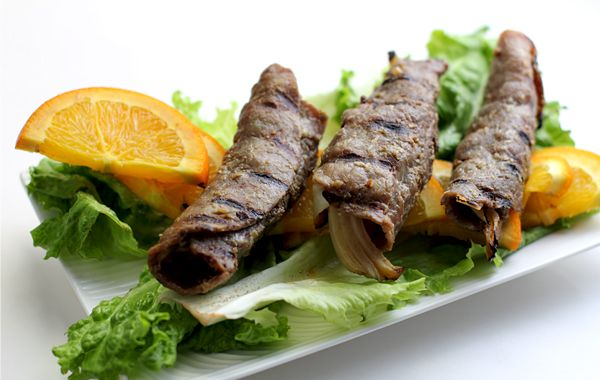Vietnamese beef rolls, called bò hành huong, are typically considered a festive dish. We had a lot of guests over last week and I decided to serve this Vietnamese beef specialty as the main course for my buffet party menu. The name translates to “onion scented beef”, and that is an apt description. The authentic version would use green onions, but I didn’t have any, so I substituted thin wedges of regular onions for the filling. It didn’t alter the main flavor of the dish.
And since people eat with their eyes first, I made sure the presentation of the rolls was inviting. I served them on a bed of lettuce with slices of citrus from our garden.
1. Info for Bo Hanh Huong Recipe (Vietnamese Beef Rolls)
- Cook Time: 40 mins
- Total Time: 4 hrs
- Servings: 4
- Calories: 619kcal
2. Ingredients for Bo Hanh Huong Recipe (Vietnamese Beef Rolls)
- 2 pounds “outside” flank steak (see tips), sliced paper-thin
- 1 yellow onion
- 1½ tablespoons five spice powder
- 1 tablespoon honey
- 1 tablespoon lemon grass, finely chopped
- 1 teaspoon mushroom seasoning salt
- 1 clove garlic, finely minced
- 3 tablespoons vegetable oil
3. Directions:
3.1 Prepping the onion
Soak the wooden skewers in water for about 30 minutes. This step will prevent the wood from burning when put on the grill.
Peel and cut the onion into thin wedges. Blanch (dip for 5 seconds in boiling water then transfer to an ice-cold bath), drain thoroughly and pat dry on a paper towels. Sprinkle with salt.
Remove as much excess liquid as possible and pat dry one more time with paper towels.
3.2 Marinating the beef
In a bowl, combine the baking powder, lemon grass, five spice powder and red chili powder. Rub the beef with the spiced powder. Add the garlic and honey. Drizzle about 1 teaspoon of vegetable oil, chill and allow to marinate for 5 minutes.
Remove the beef from the refrigerator so the meat returns to room temperature.
3.3 Assembly time
Pat the meat dry and season with salt and pepper. Using a cutting board, spread the thin slices of beef, stacking them next to each other and form about a 10-inch long piece. Place several onion wedges in the center and tightly roll the meat around the onions into tight cylinders. Each stack of beef is rolled around the onion wedges. Don’t over-stuff the beef or the roll will burst; the diameter of the roll should measure about 1½ inches. Repeat until all the beef is used.
You could secure the rolls with toothpicks but I threaded the beef rolls onto two skewers, forming a grid between the beef rolls and the wooden skewers. Brush the beef with a little canola oil.
With a brush, grease a cast iron skillet grill (a regular frying pan would work but you won’t get the nice grill marks) and heat until it’s really hot, almost at the smoking point. Place the beef on high heat for 4 minutes using tongs. It’s important that you do not pierce the meat so it stays moist and tender. You want to create nice grilling marks. Flip the meat on the other side. Grill for 3 minutes to medium doneness.
Transfer the beef to a platter. Cover with a piece of aluminum foil.
Place on a bed of lettuce and garnish with thin slices of orange.
Serve immediately.
Bon appétit!
4. Tips and advices:
- Technically, I do not use flank steak but the outside flank of the steak (the best part), called nam. Just mention to your butcher you’re making bò hành huong. You could also ask your butcher to slice the meat deli-thin for you. If you don’t have an Asian market nearby, you could always use tender rib-eye steak or top sirloin (which is less tender though). If you’re slicing the meat yourself, placing the meat in the freezer for 15-20 minutes beforehand helps you control the thickness of each slice of meat. Make sure the slices are as thin as you can make them. Also make sure the meat is sliced against the grain to ensure optimum tenderness.
- Little reminder on how to make the lemon grass purée: Wash the lemongrass. Remove all the white powder off from of the leaves. Cut the stalk in half. Crush the younger part with the back of a chef’s knife and set it aside (you can use it for making broth).Cut the remaining stalk into extremely thin slices using a chef’s knife. In a mortar and pestle, grind the thin slices of lemon grass, then transfer and mix everything using a mini food processor. It should turn into a fine moist powder. Set aside.
- The ingredients listed can be found in most Asian specialty markets.

